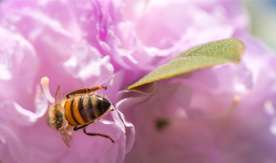Enhancing honey bee populations by increasing beneficial pollinator flowers

A group of University of Maine researchers is working to enhance native and honey bee populations by increasing beneficial pollinator flowers across Maine's landscape. This is not a new idea—what is new is their choice of research location. Some might describe one of their sites as trashy, but the researchers think it's just what they need.
The researchers—Alison Dibble, Lois Stack, Megan Leech, and Frank Drummond—are planting pollinator demonstration gardens at the inactive Pine Tree Landfill in Hampden and at G.W. Allen's Blueberry farm located in Orland. Both plots will be used to educate farmers and community members about strategies that they can adopt to help keep bee communities thriving in the state.
"This project is important because one of the many hypothesized stressors that have been implicated in bee decline, including honey bees and native bees, is not having enough floral resources, which provides the pollen and nectar essential for bees," says Drummond, professor of insect ecology.
Funded by the Natural Resource Conservation Service, the two-year project's objective is to identify plantings—annuals, herbaceous perennials and woody shrubs—that are most beneficial to bees across Maine's terrain, which is dominated by forest ecosystems that are not particularly conducive to bee life.
By enhancing habitats to fit the needs of pollinators, the researchers are giving back to the tiny buzzing insects that provide our agricultural systems with the crucial service of pollination.
As bees forage for food, they pollinate flowering plants by depositing pollen on the flower's stigma, the receptive part of the plant's female reproductive organ. The pollen will then germinate and fertilize the flower to produce fruits and seeds.
Conservation biologists in Maine, as well as worldwide, have raised concerns about declines in bee abundance and species diversity. Due to conversion of landscape for residential and commercial uses, natural bee habitats are being eliminated, which could have serious implications to various agricultural crops in Maine, such as blueberries.
According to David Yarbrough, professor of horticulture and a wild blueberry specialist for University of Maine Cooperative Extension, last year's harvest of wild blueberry crops in Maine brought in a $250 million monetary return. In 2014, Maine produced and harvested more than 104 million pounds of blueberries made possible, in part, by the free services bees provide.
According to the United States Department of Agriculture Forest Service, bees provide pollination to 80 percent of all flowering plants and 75 percent of fruits, nuts and vegetables grown in the U.S. About 25,000 species of bees are known throughout the world and Maine is home to more than 270 species of native bees.
During the demonstrations, researchers and educators will discuss plants that are best utilized by bees and will stress the need to avoid flowers and shrubs treated with systemic insecticides because they can be detrimental to bees, says Drummond.
"It's not just about planting flowers: it's about planting flowers that are safe for the bees," he says. Both sites will help researchers, farmers and educators better understand how these plots should be managed in order to be successful both agriculturally and ecologically. The first demonstration date has not been set, but the researchers are aiming to hold one in mid-August.
Pine Tree landfill, the first site for the demonstration, is managed by Casella Waste Services, which owns more than 400 landfills in the Northeast. If all goes well, the company hopes to host more pollinator gardens on their landfills, transforming unused land into flower-filled paradises for bees.
"I think the landfill is a great location for this project because it's a piece of land that is not currently being used. Right now they use the methane that comes from the landfill to produce energy. So if we can use the same land for something else that is a good cause, it's a win-win," says Leech, a graduate student working with Drummond.
Leech's master's thesis is focused on flower nutrition, specifically whether bees visit flowers with higher nutritional value more frequently. She's also looking at other floral characteristics that would impact flower nutrition such as nectar and pollen. The idea for her thesis sprouted while working on Dibble's bee module project, when she observed bees showing a preference for some flowers over others, and wondered if it was related to nutrition.
The bee module—a five-year project started in 2012—is aimed at determining which plants elicit the most bee visitations in order to create a baseline of what plants should be selected for the pollinator demonstration sites. In order to collect the data, Dibble setup 36 plots within 100-foot-by-100-foot areas on three Maine blueberry fields and at the University of Maine Rogers farm. By placing plots side-by-side, researchers were able to collect observations of bee visitations on a variety of different planting selections, which will help to better inform their recommendations to farmers.
The data they collect, which will focus on the success of flowering plant germination and bee visitation preferences, will be looked at over the next two years to determine if the increase in floral resources was beneficial to the bee populations.
Promoting the health of bee populations is relatively inexpensive in terms of the alternative, which is trying to pollinate plants without bees. If farmers planted pollinator plots next to their agricultural crops, they could decrease rental costs for honeybees, which are usually imported by farmers during the planting season, says Drummond.
Drummond hopes the project will encourage nonfarmers to invest in pollinator plantings for municipalities, private homes and state agencies, so—on a landscape level—bee numbers can increase.
"In the past, we've mostly been focusing on the farmers. But what makes this project more unique is that we are trying to provide outreach for the nonfarmers who can also have an impact on improving bee communities on the landscape," says Drummond.
Provided by University of Maine


















